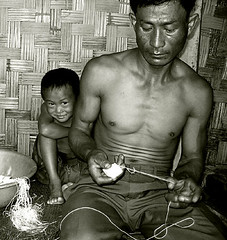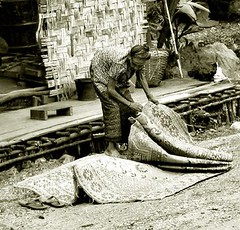BAN KIUKACHAM—It isn’t everywhere you can get a pound of soft narcotics for less than $5. Nor is it everywhere that a mere 2/5ths of the population can read and write in their native tongue. In this forgotten place, nestled deep within the rugged mountains and lush valleys of the Mekong River, the people of Laos have finally found their salvation. This time around, it comes in the form of an untrained, unarmed, unstoppable Canadian philanthropist and, of all things, her schoolhouse full of kids.
It’s early November 2005, on a bitter-cold evening at the Academy of Spherical Arts, Toronto’s reigning upscale hangout for a mix of billiards and business. The room is filled with friends and supporters, family and strangers, and plenty of fresh sushi and roast beef. One-of-a-kind paintings hang from the exposed brick walls, and the silent charity auction keeps them under careful watch for most of the night. By 10:00, that same art has raised enough financial support to send over 2,000 books to the children of rural Laos.
On stage, a string of impressive international artists, comedians and musicians keep the audience at bay, as the real star of the evening, the graceful 30 year old painter and social activist, Sylvia Charczuk, prepares to give the crowd their first real taste of child poverty in 21st century Asia.
 In the so-called Kingdom of the Million Elephants, the Laoation people have discovered the ultimate paradox. Yet another tragedy of misguided French imperialism, the country found itself both unwilling and unable to deal with the colonial vacuum of power that formed in the wake of World War II. With France no longer around to guide them through the subtle nuances of Bretton Woods and the Marshall Plan, and a string of domestic politicians too weak and corrupt to govern for themselves, Laos was forced to look beyond its borders once again for guidance and support. Not surprisingly, there were two very eager volunteers waiting quietly in the wings.
In the so-called Kingdom of the Million Elephants, the Laoation people have discovered the ultimate paradox. Yet another tragedy of misguided French imperialism, the country found itself both unwilling and unable to deal with the colonial vacuum of power that formed in the wake of World War II. With France no longer around to guide them through the subtle nuances of Bretton Woods and the Marshall Plan, and a string of domestic politicians too weak and corrupt to govern for themselves, Laos was forced to look beyond its borders once again for guidance and support. Not surprisingly, there were two very eager volunteers waiting quietly in the wings.
On the left of Laos’ impressionable post-War parliament, Kong Le’s neutralists slipped all too easily under the spell of Russian support, while the rightist Nosavan regime found its political salvation in the welcoming arms of the United States Army. So began the Vietnam War, in the heart of the Siamese peninsula, and with the world’s only remaining superpowers flexing smugly on both sides, the fault lines were painfully obvious.
Throughout the ensuing conflict, Laos earned itself the rather dubious distinction of taking the heaviest (mostly American) ballistic payload in the history of modern warfare. Even today, long after the fall of the Iron Curtain, the country has yet to recover. Countless children a year are still killed by the 8-24 million unexploded ordinances (UXOs) scattered across 15 of the country’s 18 provinces, and most of the rural population has yet to regain access to potable water.
But more than just the raw physical damage and the barren political wasteland that were spawned by the “us-or-them†dichotomy of the Cold War, the one truly painful reality for Laos is that, as a land-locked country under a sluggish Communist regime, it has been chronically incapable of reversing a cycle of poverty which, to this day, still consumes nearly 50% of the population.
 It is precisely this endless string of tragedy that first drew Charczuk into the country’s volunteer fold almost three years ago. During the summer of 2003, while giving private English lessons in downtown Tokyo, Charczuk was surprised to discover that one of her closest Asian neighbours, and in fact, a former colony of Japan, was sporting one of the highest twin social deficits (illiteracy and poverty) in the developing world. Eager to find out more, she sold-off a few of her paintings, packed up her Thai pants, grabbed her Lonely Planet guide, and headed straight for the heart of Asia’s cultural darkness. Once on the ground, it didn’t take long for that darkness to set in. “I hadn’t seen poverty like that since rural Mexico†Charczuk insists. “And even then, it just wasn’t the same.â€
It is precisely this endless string of tragedy that first drew Charczuk into the country’s volunteer fold almost three years ago. During the summer of 2003, while giving private English lessons in downtown Tokyo, Charczuk was surprised to discover that one of her closest Asian neighbours, and in fact, a former colony of Japan, was sporting one of the highest twin social deficits (illiteracy and poverty) in the developing world. Eager to find out more, she sold-off a few of her paintings, packed up her Thai pants, grabbed her Lonely Planet guide, and headed straight for the heart of Asia’s cultural darkness. Once on the ground, it didn’t take long for that darkness to set in. “I hadn’t seen poverty like that since rural Mexico†Charczuk insists. “And even then, it just wasn’t the same.â€
Armed with only a translator and an overdeveloped sense of philanthropy, she arranged for an audience with the local village chief in the tiny hamlet of Ban Kiukacham. “I immediately felt that this was the village,†she admits. And with equal conviction, the villagers somehow knew that she would become their savior.
So began Charczuk’s fledgling relationship with the Council of Elders. Their biggest collective challenge was to find a way to distribute “charity†into an archaic Command Economy, without being thrown directly in jail. At that point, the intrepid Canadian didn’t have any authority to bring capital into the country, nor were her charitable impulses endorsed by the powers that be. As Charczuk quickly discovered, starting a Communist charity from scratch was a very delicate art.
To overcome the country’s massive Soviet bureaucracy, she prepared a formal report entitled “Development Strategies for Ban Kiukacham and its Surrounding Villages,†in concert with the chiefs, prefects, Laoatian ambassadors, and of course, the ruling Communist Party. Two phases of development were initially proposed, each more expensive than the next, but all with the same shared goal of promoting health, education and general well-being among Asia’s forgotten generation.
Phase 1 involved sending five high school students to study teaching and nursing in Luang Prabang, the regional hub for post-secondary education, with the only stipulation being that they return to the village to share what they’ve learned. Financial incentives were also set up to encourage best practices among the existing primary school teachers, and a sports fund was created to encourage proper health, nutrition and physical conditioning.
Phase 2 was much more aggressive, and called for enough fund-raising (almost US$20,000) to build a brand new academic “complexâ€, housing both a kindergarten and village library. According to the plan, their shelves would be filled with popular Laoatian books, many of which simply aren’t available in the poverty-stricken backwaters of a dilapidated regime. Promoting literacy and well-being was really that easy. In the end, someone simply needed to care.
 To be sure, the real beauty of the Chi-Ki Children’s Foundation (www.chiki.ca) is quite possibly that same unbridled simplicity. There is no obvious agenda to hide, no towering hierarchy to support, no bloated CEOs to pay, no public officials to bribe and no private taxes to avoid. Its character is fundamentally personal; just grassroots philanthropy to the very core. In essence, Charczuk was starting something the country’s own socialist government had never truly considered: providing basic social security for its citizens. “I returned to Tokyo with a lighter bag,†she admits, “but my head was full of ideas.â€
To be sure, the real beauty of the Chi-Ki Children’s Foundation (www.chiki.ca) is quite possibly that same unbridled simplicity. There is no obvious agenda to hide, no towering hierarchy to support, no bloated CEOs to pay, no public officials to bribe and no private taxes to avoid. Its character is fundamentally personal; just grassroots philanthropy to the very core. In essence, Charczuk was starting something the country’s own socialist government had never truly considered: providing basic social security for its citizens. “I returned to Tokyo with a lighter bag,†she admits, “but my head was full of ideas.â€
Back home in Toronto, playing the consummate fund-raising crusader, her load is anything but light. For three straight years now, Charczuk has been campaigning tirelessly for the forgotten children of Laos, and while her resolve only grows stronger with every dollar raised, sometimes she can’t help but feel overwhelmed. When asked about her efforts, though she’s loath to admit it, she would probably love some “Big Three†support to keep the project humming along (i.e. UNICEF, Feed The Children and the United Way). For now, she simply takes to quoting Emerson. “How much of life is lost in waiting?†she asks. “I think these kids have waited long enough.â€